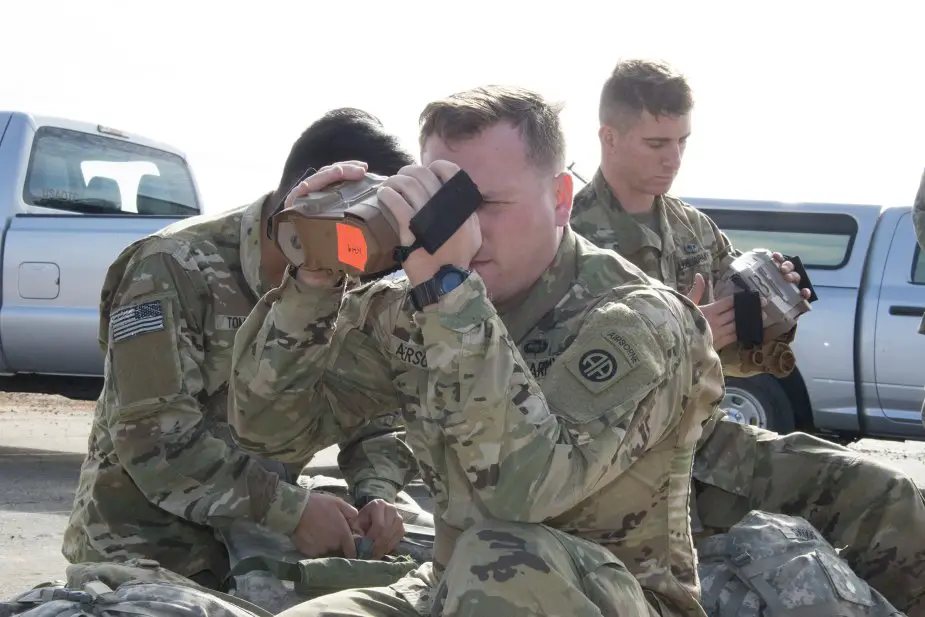Breaking news
Smaller laser targeting device for US airborne forces.
The Airborne and Special Operations Test Directorate here, in conjunction with elements of the 82nd Airborne Division, completed final phases of Airborne testing for the Laser Target Locator Module, or LTLM II, recently. The primary mission of the LTLM II is to provide accurate targeting data to execute effective fires with artillery and mortars. "The LTLM II provides the dismounted squads the capability to obtain targeting data, no matter the weather conditions or location," said Staff Sgt. Marcus Love, Test NCO with ABNSOTD.

Sgt. Matthew Anderson, a Fire Support NCO, conducts post-drop inspections of his LTLM II after jumping at Fort Bragg, N.C.’s Sicily Drop Zone (Photo credit: Rebecka Walter, Audiovisual Production Specialist, Airborne and Special Operations Test Directorate, U.S. Army Operational Test Command)
As explained by Mike Shelton, Airborne and Special Operations Test Directorate, U.S. Army Operational Test Command Public Affairs, although tested previously, the current LTLM II is reduced by both size and weight, which is a critical performance parameter for Airborne forces that are limited to man portable systems to support forced entry operations. "The reduced size and weight make the LTLM II an attractive tool for providing a critical and immediate need for a lightweight, day/night capability to determine threat target data," said Love.
More accurate fires due to more accurate targeting data provided by the LTLM II will also help reduce threats to non-combatants and civilian structures in built up and urban environments. LTLM II testing was conducted by the ABNSOTD, U.S. Army Operational Test Command and elements of the 82nd Airborne Division and Special Operations Command.
Testing began with new equipment training, or NET, administered by trainers from Program Executive Officer Soldier. The purpose of NET is to ensure that paratroopers participating in testing are adequately trained to employ the system under test. During the LTLM II NET, paratroopers were trained in system characteristics, employment, operation, target engagement, troubleshooting and maintenance of the LTLM II. During formal testing, the paratroopers participated in testing act as both operator and maintainer of the test article. Upon completion of NET, the test team conducted 22 static line and 22 military free fall test iterations simulating forced entry operations. SL test iterations were conducted using a contracted CASA-212 aircraft at jump altitudes of up to 1,200 feet above ground level, or AGL with MFF testing conducted at altitudes of 12,000 and 17,000 feet AGL.
Upon completion of each airdrop iteration, paratroopers participating in testing conducted a post drop inspection and power-up test of each system followed by a daylight target engagement exercise to ensure each system was fully functional and performing within the manufacturer guidelines after the airdrop.
Following the daylight jumps, paratroopers participating in testing were presented a series of ground targets during hours of limited visibility and were required to determine range to target, direction and vertical angle to target. Spec. Chase Stevenson, a Forward Observer with the 1st Battalion, 319th Airborne Field Artillery Regiment, said the reduced size and upgraded capabilities could be extremely useful for Airborne fire supporters.
For the duration of the operational test, all systems evaluated were found to be 100% mission capable subsequent to Airborne infiltration. Spec. Martinez Chamorro, D Company, 307th Airborne Engineer Battalion, said, "The LTLM II is a ruggedized system for military use. Some military equipment I have worked with previously did not withstand the rigors of Airborne service." Sgt. Robert Welsh Jr. of E Company, 307th Airborne Engineer Battalion, 3rd Brigade, 82nd Airborne Division, said, "The LTLM II is well-rounded, versatile, and easy to use." The successful Airborne test trials will result in paratroopers Army-wide employing the LTLM II to deliver more accurate and timely fire support assets subsequent to forced entry operations and during follow on missions. "USAOTC is the U.S. Army's only independent operational test organization," said Sgt. Major Danny Boivin, Sergeant Major of the ABNSOTD.
"We test and assess Army, Joint, and Multi-service Airborne and airdrop related warfighting systems in realistic operational environments, using Soldiers to determine whether the systems are effective, suitable, and survivable," he said. "Any time Soldiers and their leaders get involved in operational testing, they have the opportunity to use, work with, and offer up their own suggestions on pieces of equipment that can impact development of systems that future Soldiers will use in combat."
The U.S. Army Operational Test Command is based at West Fort Hood, Texas and its mission is about making sure that systems developed are effective in a Soldier's hands and suitable for the environments in which Soldiers train and fight. Test units and their Soldiers provide feedback, by offering input to improve upon existing and future systems with which Soldiers will ultimately use to train and fight.
The Fort Bragg, N.C.-based Airborne and Special Operations Test Directorate plans, executes, and reports on operational tests and field experiments of Airborne and Special Operations Forces equipment, procedures, aerial delivery and air transportation systems in order to provide key operational data for the continued development and fielding of doctrine, systems or equipment to the Warfighter.


























